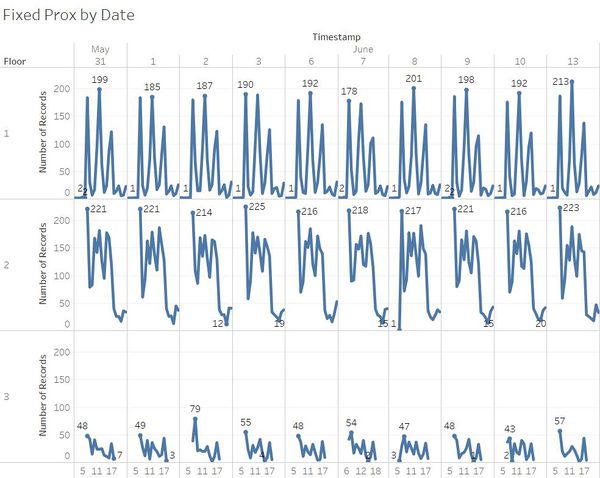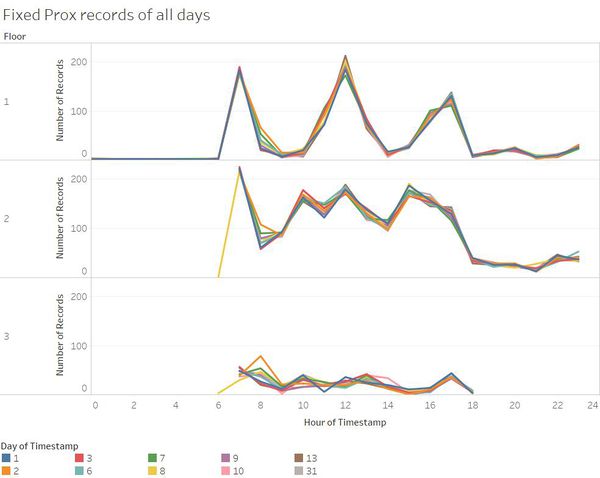IS428 2016-17 Term1 Assign3 Lim Zi Yu Jouta
Contents
- 1 Data Preparation
- 2 1. What are the typical patterns in the prox card data? What does a typical day look like for GAStech employees?
- 3 2. Describe up to ten of the most interesting patterns that appear in the building data. Describe what is notable about the pattern and explain its possible significance.
- 4 3. Describe up to ten notable anomalies or unusual events you see in the data. Prioritize those issues that are most likely to represent a danger or a serious issue for building operations.
Data Preparation
...
1. What are the typical patterns in the prox card data? What does a typical day look like for GAStech employees?
Upon looking at the data for the fixed prox zones, I noticed that there is no data for 4th June. Unlike 5th, 11th or 12th June with very few records, no data has been recorded at all for 4th June. This suggests either that data was deliberately not recorded or simply no one had visited any of the fixed prox card zones in the office that day.
On the other hand, for the mobile prox zones i.e. Rosie’s prox card sensor, there are no data for 4th, 5th, 11th or 12th June, which are all weekends. I believe that this shows that Rosie does not work on weekends. Rosie makes her rounds every weekday starting from 2 time slots, 0900h and 1400h. The only exception to this is on 2nd June, when her duties were extended beyond 1000h.
Firstly, I looked at the daily records for the 3 floors, after removing data for the 4th, 5th, 11th and 12th as I did not want to have the outliers affect things.
The data patterns for the fixed prox card sensors record count for each floor are largely the same each day.
Some patterns that I observed that seemed to be unusual:
- 8th June sees a consistent number of records across all 3 floors at 6am, which is usually not observed for the 2nd and 3rd floors.
- 2nd June sees a sudden peak in number of records at 8am on the 3rd floor, which is the highest out of all data collected for the 3rd floor. Unlike most days for the 3rd floor, 2nd and 8th June sees a rise in records before dipping.
The graph above shows has each pane displaying the zone per floor, with each line representing a day of the data.
The data graphs for zone 4, the elevator and stairs area, of floor 1 and 2 shows 3 consistent peaks at the timings of 7am, 12pm, 5pm. Those timings are likely to be the timings people start work, people have lunch, people leave work. The data shown here is largely consistent, with one glaring issue being the singular point and record on floor 1 zone 5, which happened on 31st May 1128h, which is rather questionable as a lone case.
Overall for the fixed prox cards data, the records appear to be rather consistent, which can be attributed to the fixed locations of the data and routine behavior at work.
The mobile prox card data gives data for the location in the form of floor and X, Y coordinates. Using Tableau’s “Background Images” after cropping the proximity zone maps to just the map, changing the type of data for X and Y to longitude and latitude respectively, it becomes possible to display the mobile prox data points on the “map” corresponding to the coordinates. This creates a visualization showing the spatial distribution of the prox card scans, with color to show the number of records.
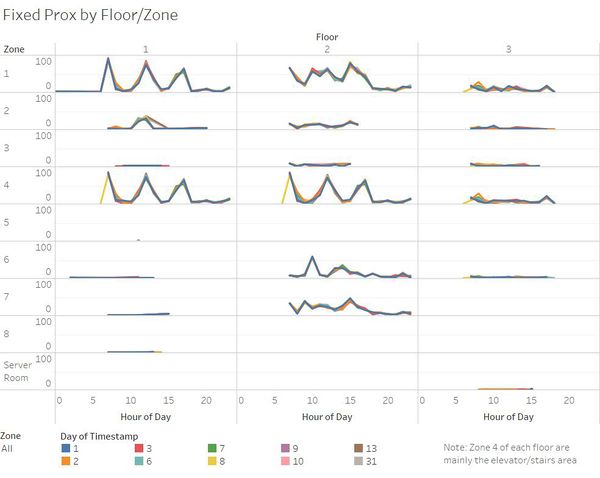
The graph above shows has each pane displaying the zone per floor, with each line representing a day of the data.
The data graphs for zone 4, the elevator and stairs area, of floor 1 and 2 shows 3 consistent peaks at the timings of 7am, 12pm, 5pm. Those timings are likely to be the timings people start work, people have lunch, people leave work. The data shown here is largely consistent, with one glaring issue being the singular point and record on floor 1 zone 5, which happened on 31st May 1128h, which is rather questionable as a lone case.
Overall for the fixed prox cards data, the records appear to be rather consistent, which can be attributed to the fixed locations of the data and routine behavior at work.
The mobile prox card data gives data for the location in the form of floor and X, Y coordinates. Using Tableau’s “Background Images” after cropping the proximity zone maps to just the map, changing the type of data for X and Y to longitude and latitude respectively, it becomes possible to display the mobile prox data points on the “map” corresponding to the coordinates. This creates a visualization showing the spatial distribution of the prox card scans, with color to show the number of records.
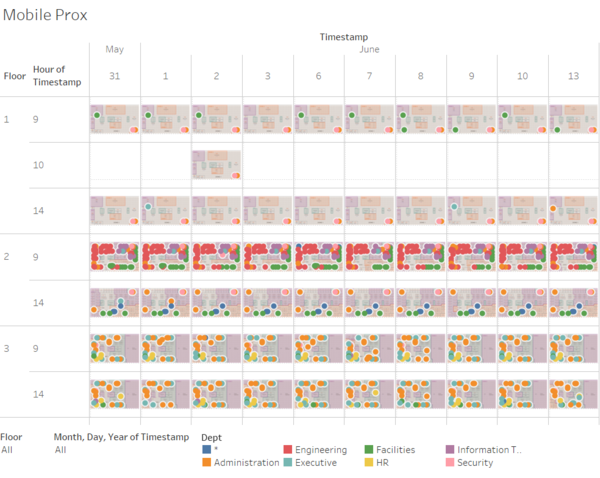
From this plot, we observe that the data for mobile prox scans are generally quite consistent, perhaps due to the fact that data is always captured around 9am and 2pm, with 2nd June being an outlier to it due to scans continuing into the 10am range for floor 1, likely due to Rosie’s duties being extended. Something might have taken place on 2nd June at floor 1 that lead to Rosie extending timing for her duties that does not take place on other days.
The typical day at GAStech starts at 7am, lunch at 12pm, work ends at 5pm. People generally stick to their daily routines without much deviation hence leading to similar data values recorded each day.
The prox id appears to follow the format of taking the first alphabet of the first name and join it with the last name followed by a 3-digit number. Using the prox card records and employee list, we are able to figure out the details of the prox card scans. I used Microsoft Excel to create a mapping of the employee list to the prox card scan records. One thing I noticed here is that 2 members on the employee list were not reflected in the prox card records, Alcide Pherigo and Edvard Vann from the Security Department.
2. Describe up to ten of the most interesting patterns that appear in the building data. Describe what is notable about the pattern and explain its possible significance.
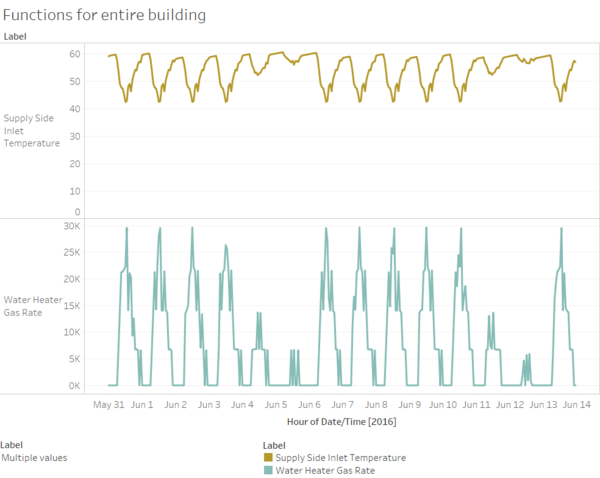
Water Heater Gas Rate peaks around 1 pm each day. Supply side inlet temperature dips at around 1 pm each day. The data reflects that the spike in gas rate happens around 1pm each day even if the temperature dip in the water coming in is not that much. Perhaps one way to save on electricity and increasing efficiency of the water heating system is for the heating to only begin when the temperature falls below a baseline set, such that unnecessary energy wasted to start each heating cycle can be minimized. The current way of managing is good in having a routine cycle but it may not be able to adjust in times of extreme changes.
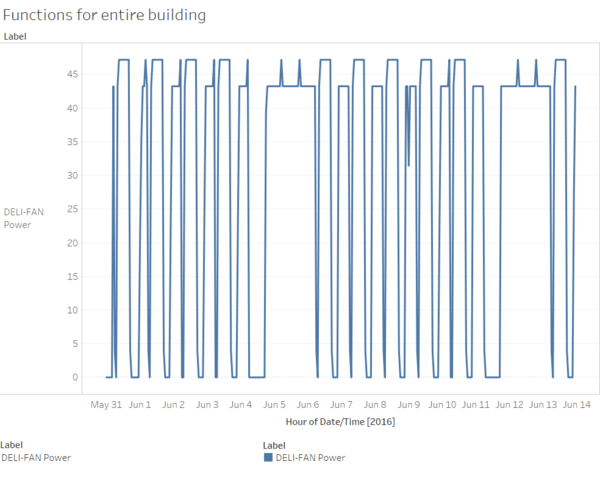
The deli exhaust fan spikes in power around timings when people start working and end work. On both weekends captured in the data however, the deli exhaust fan has been observed to run at rather high power levels throughout the weekend despite the supposed lack of people in the office.
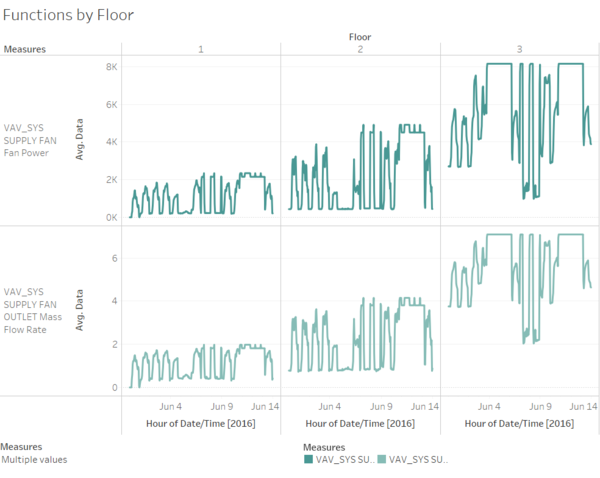
The changes in power used by the HVAC system fan is consistent with the changes in temperature of the air exiting the HVAC system to the different zones. Power is used by the HVAC system in maintaining a suitable indoors environment, whereby temperature of the working environment is one to be considered.
We also note that the average power and flow rate increases as the floor number rises. This may imply the location of the HVAC system fan to be at floor 1 hence requiring more power and flow to delivery to the upper floors.
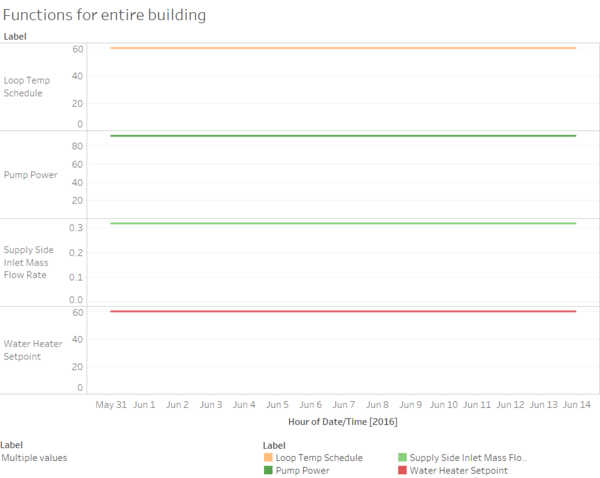
All of the measures here are mainly settings to ensure regulated maintenance of the office HVAC setting environment. The system has been efficient in keeping things maintained at the constant settings, however more consideration may be put in setting the levels to be maintained. For example, weekends when no employees are expected to be around for could see changes in the settings as the building does not need to be running at optimal settings, but could be more cost efficient by lowering the settings.
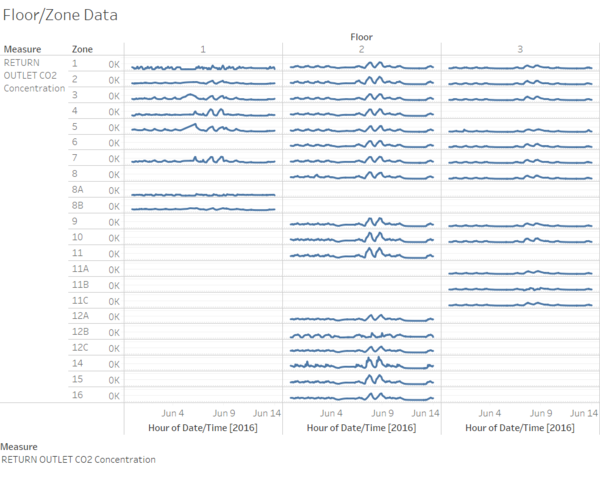
CO2 levels remain largely consistent throughout all zones for floors 2 and 3, which could be due to how floor 2 and 3 are largely offices unlike floor 1 which serves as the entrance and has facilities like the deli.
For the data on floor 2, we observe two spikes on 7th and 8th June.
